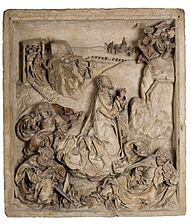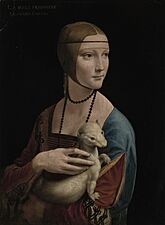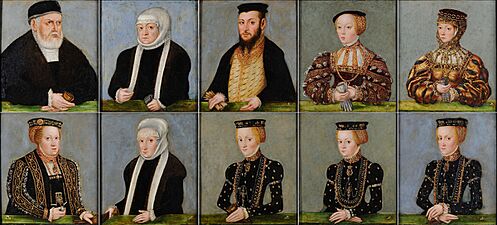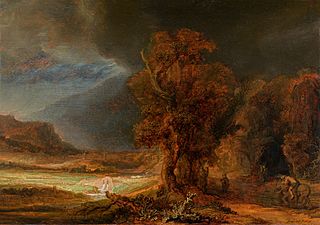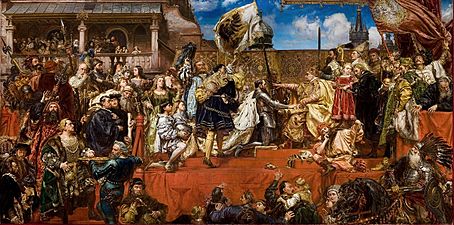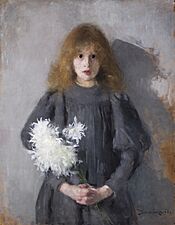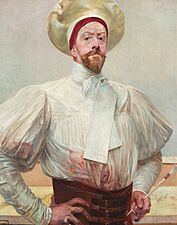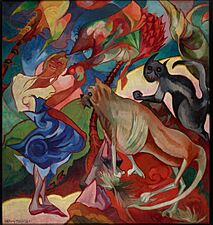National Museum in Kraków facts for kids
 |
|
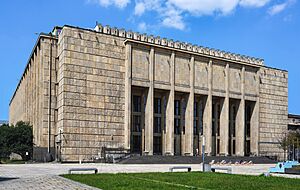
Main Building
|
|
| Established | 7 October 1879 |
|---|---|
| Location | 3 Third of May Avenue Kraków, Poland |
| Type | National museum |
The National Museum in Kraków (called Muzeum Narodowe w Krakowie in Polish), often shortened to MNK, is the biggest museum in Poland. It was started in 1879. The museum has 21 different sections, including 11 galleries, 2 libraries, and 12 workshops where they fix old art. It holds about 780,000 art pieces. These range from very old items from classical times to modern art. The museum is especially known for its collection of Polish paintings. In 2023, over 1.85 million people visited the museum. This made it the third most-visited art museum in Poland and the 38th most-visited art museum in the world.
Contents
Where to Find the Museum
The Kraków National Museum first opened in the upper part of the Renaissance Sukiennice building. This building is in the Main Square in the Kraków Old Town. Today, this spot is still one of the museum's most popular locations.
The museum's main building, called the New Main Building, is on 3 Maja Street. Construction started in 1934 but stopped during World War II. It was finally finished in 1992. The museum's huge collection, with hundreds of thousands of items, is mostly kept in this Main Building. This is also where the museum's offices are. However, parts of the collection are also displayed in nine other locations around the city.
During World War II, many items from the museum's collection were taken by German forces. After the war, the Polish Government got many of these artworks back. But more than 1,000 items are still missing. One famous missing painting is The Fight Between Carnival and Lent by Pieter Bruegel the Elder. This painting was given to the museum in 1937. Polish authorities believe it was stolen in 1939.

What You Can See: The Collections
The Main Building has a newly updated gallery called the Gallery of the Twentieth Century Polish Art. This is one of the biggest galleries in Poland for paintings and sculptures from the late 1800s onwards. You can see famous works by artists like Jacek Malczewski, Leon Wyczółkowski, and Włodzimierz Tetmajer. There's also a large collection of art by Stanisław Wyspiański. The gallery also shows art from after the wars, including Polish cubists, expressionists, and modern artists from the 1960s.
The museum's painting collection includes amazing works from the Young Poland art movement. Some artists featured are Konrad Krzyżanowski, Olga Boznańska, and Józef Pankiewicz. Polish modern art is shown through artists like Zbigniew Pronaszko and Leon Chwistek.
Art from after World War II includes pieces by Tadeusz Kantor, Jonasz Stern, and Maria Jarema. You can also see works by many important modern Polish artists. These include Grzegorz Sztwiertnia, Rafał Bujnowski, and Wilhelm Sasnal.
Old Weapons and Armor
The museum's arsenal building has a huge display of military items from the 1100s to the 1900s. This includes Polish armor from the 1500s and 1600s, Polish sabers (swords), old firearms, and military uniforms. You can also see military awards and medals. The museum also has weapons from Western and Eastern Europe. These military items are shown in an exhibition called "Arms and Colours."
Beautiful Arts and Crafts
The Decorative Arts and Crafts Gallery displays beautiful items like gold, silver, and jewelry from the 1100s to the 1700s. There are also objects made from copper, pewter, and iron, such as bowls and old chests. You can see antique furniture, musical instruments, clocks, and glass items. The museum has one of Poland's largest collections of old Polish and Oriental rugs and carpets. There's also a collection of costumes from the 1500s to the 1900s.
Museum Locations Around the City
The National Museum in Kraków has several locations:
- The Main Building, at 3 Maja St., shows nearly 500 artworks by Poland's top modern artists.
- Gallery of the 19th Century Polish Art in Sukiennice has famous paintings and sculptures from the Young Poland Movement.
- Czartoryski Museum is famous for Leonardo's painting of Lady with an Ermine. It also displays other old master paintings.
- Czartoryski Library holds old handwritten books and documents from the Middle Ages.
- Bishop Erazm Ciołek Palace displays Polish Gothic, renaissance, and baroque art.
- Stanisław Wyspiański Museum is dedicated to the artist Stanisław Wyspiański.
- Jan Matejko House is on Floriańska Street.
- Józef Mehoffer House was the artist's home.
- Szołayski's House hosts temporary art exhibitions.
- Emeryk Hutten-Czapski Museum has a collection of old coins and medals.
- Karol Szymanowski Museum at Villa Atma is located in Zakopane.
- Cracovia Hotel is another location in Kraków.
In 2009, a new project called "Museum Forum" was started. It aims to show art in front of the National Museum's Main Building. A design by architect Michal Bernasik was chosen for this project.
Gallery
-
The Włocławek Goblet, 10th century
-
St Stanislaus. Gothic stained-glass window from Dominican Monastery in Kraków
-
Christ in the Garden of Gethsemane, bas-relief by Veit Stoss, ca. 1485
-
Lady with an Ermine, Leonardo da Vinci, c. 1490
-
The Family of Sigismund I of Poland, Lucas Cranach the Younger, c. 1553-1555
-
Landscape with the Good Samaritan, Rembrandt, 1638
-
Siemiradski Fackeln.jpg
Nero's Torches, Henryk Siemiradzki, 1876
-
Prussian Homage, Jan Matejko, 1879–1882
-
Podkowinski - La Folie.jpg
Frenzy of Exultations, Władysław Podkowiński, 1893
-
Polonia, Stanisław Wyspiański, 1893-1894
-
Ślewiński Władysław, Czesząca się, 1897.jpg
Woman Combing Hair, Władysław Ślewiński, 1897
-
Self-Portrait in a White Attire, Jacek Malczewski, 1914
-
Marysia with the Dog Burek on Ceylon, Stanisław Ignacy Witkiewicz, 1920-1921
Images for kids
-
Portrait of a Young Man, Raphael
-
The Fight Between Carnival and Lent, Pieter Bruegel the Elder
See Also
- Culture of Kraków
- National Museum, Poznań
- National Museum, Warsaw
- National Museum, Wrocław
- Culture of Poland
- Beautiful Virgin Mary from Krużlowa




